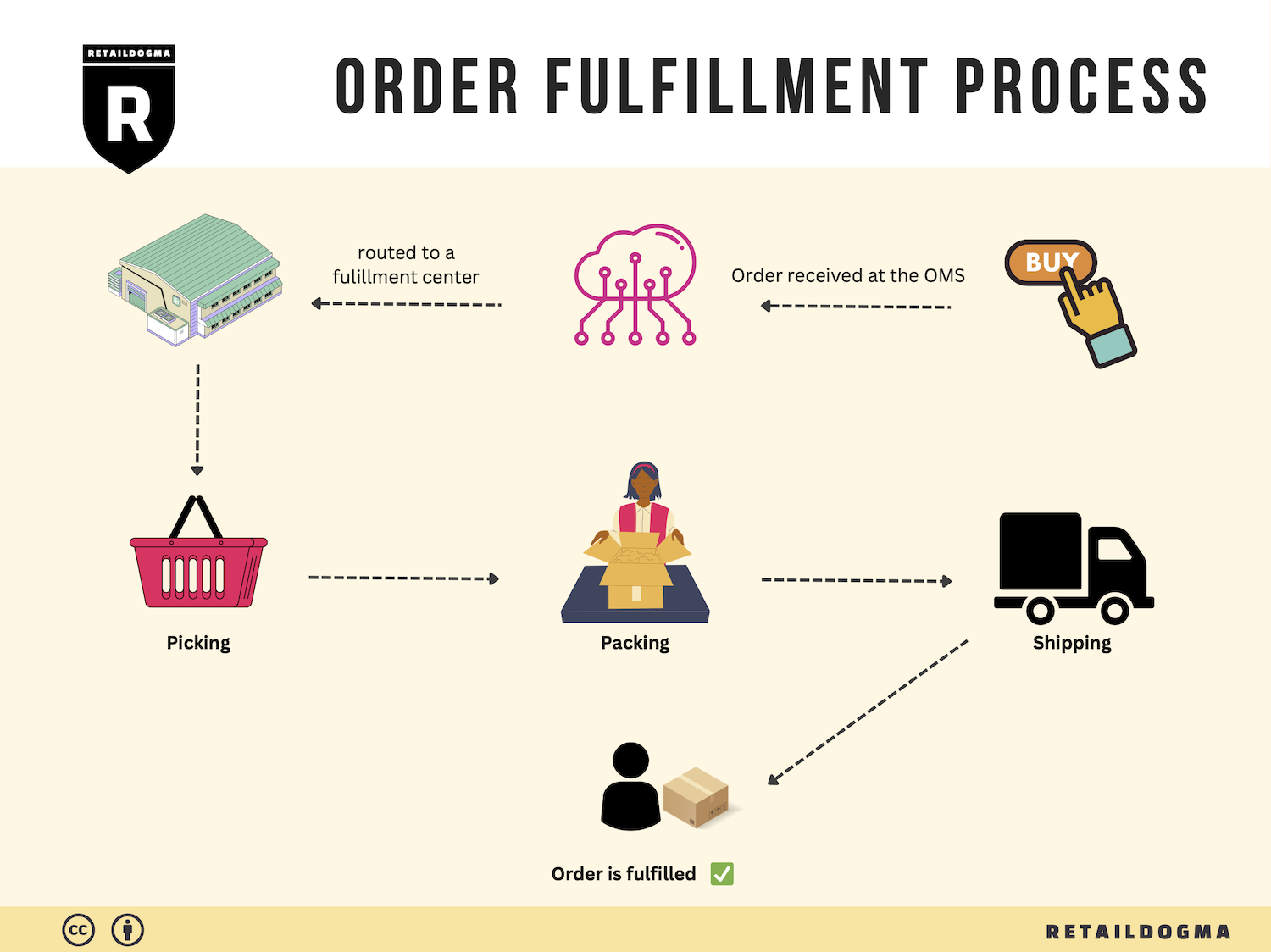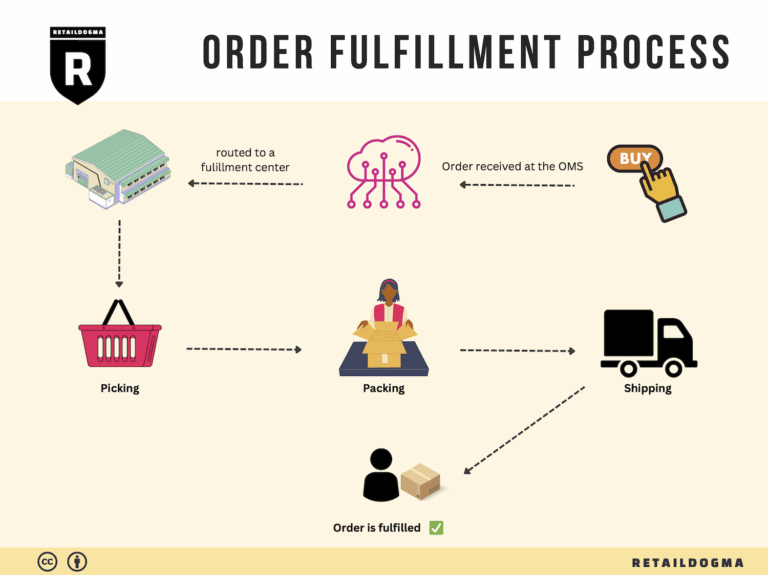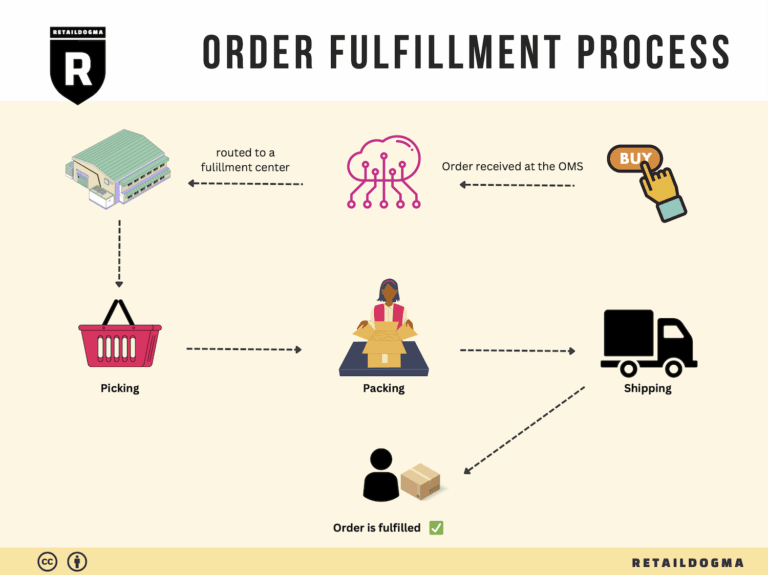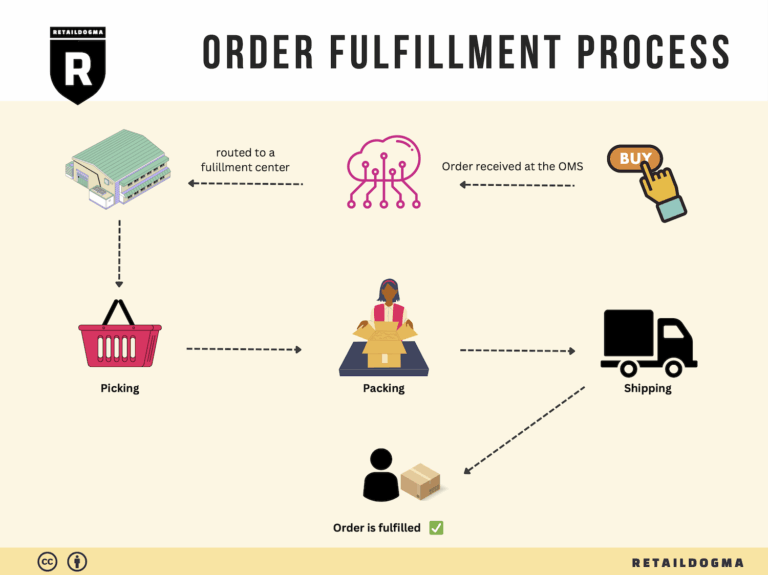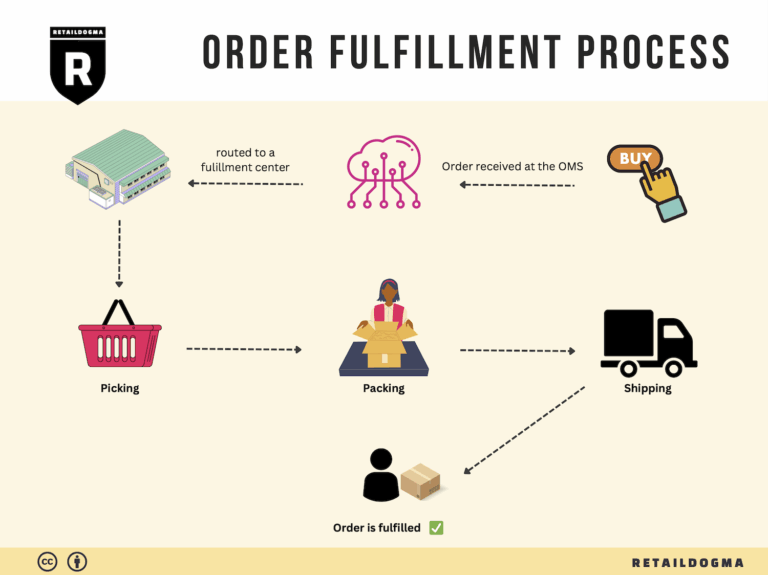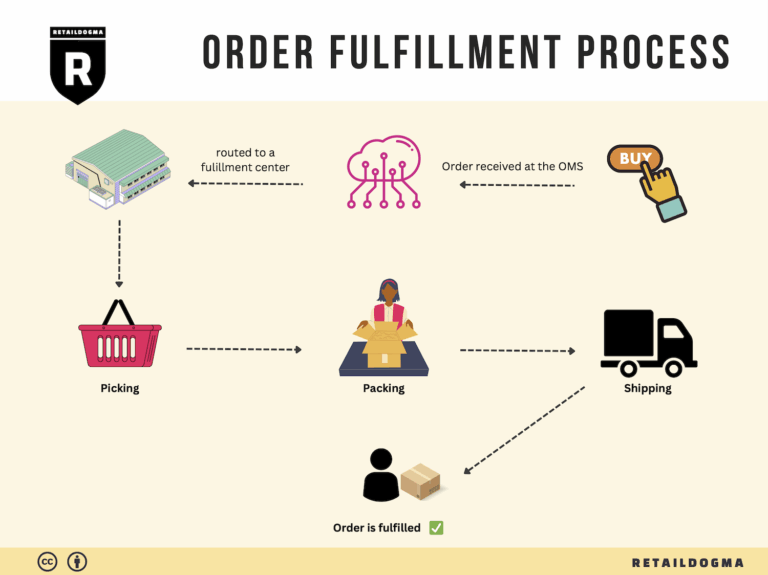What Is A Fulfillment Center? A Complete Guide (2025)
What is E-commerce Fulfillment? An Introduction for Growing Businesses
Understanding the E-commerce Fulfillment Process
As your e-commerce business grows, the excitement of increased sales can quickly turn into stress when it comes to packing and shipping orders. The fulfillment process—the series of steps involved in getting a product from your inventory to your customer’s doorstep—can become overwhelming. If you find yourself buried in boxes, packing materials, and shipping labels, you’re not alone. Many entrepreneurs face this common pain point as they scale their operations.
At its core, e-commerce fulfillment encompasses everything from receiving inventory, storing products, and processing orders, to packing and shipping items to customers. This process is critical not only for ensuring that orders are delivered on time but also for maintaining customer satisfaction and loyalty. A smooth fulfillment operation can lead to repeat customers, while delays and errors can drive them away.
This guide aims to demystify the e-commerce fulfillment landscape for growing businesses. We will explore various fulfillment models, including Third-Party Logistics (3PL) and Fulfillment by Amazon (FBA). Each model has its own advantages and challenges, and understanding these can help you choose the right approach for your specific needs.
Additionally, we will delve into the core services that fulfillment partners offer, such as inventory management, order processing, and returns handling. Knowing what to expect from a fulfillment partner can significantly reduce your workload and allow you to focus on other aspects of your business, like marketing and product development.
Selecting the right fulfillment partner is crucial for your success. We will discuss key factors to consider, including location, technology integration, customer service, and scalability. Making an informed choice can save you time and money in the long run.
Finally, we will address pricing structures associated with fulfillment services, helping you understand what to budget for and how to assess the value of different offerings.
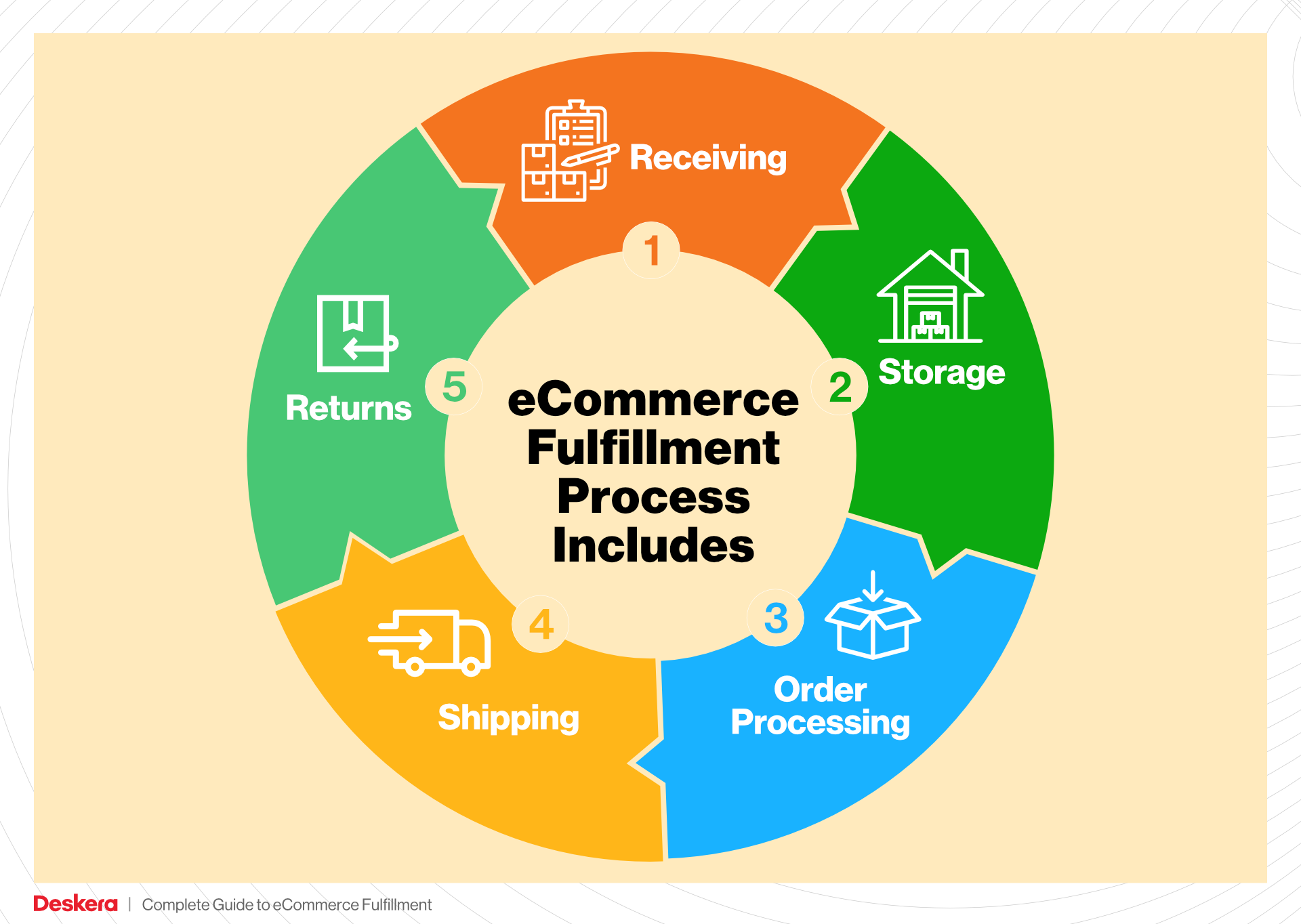
Our goal with this guide is to empower you with the knowledge needed to make smart, strategic decisions about your logistics. With the right fulfillment strategy in place, you can streamline your operations and enhance your customer experience, ultimately driving growth and success for your e-commerce business.
What You’ll Learn In This Guide
- What is E-commerce Fulfillment? An Introduction for Growing Businesses
- The Order Fulfillment Process: From ‘Buy’ Button to Customer’s Door
- Comparing Fulfillment Models: In-House vs. 3PL vs. Dropshipping
- A Deep Dive into Amazon FBA: Pros, Cons, and Who It’s For
- Core Services Offered by Fulfillment Centers
- How to Choose a Fulfillment Partner: A 6-Point Checklist
- Understanding Fulfillment Pricing: A Breakdown of Common Fees
- Frequently Asked Questions (FAQs) about Fulfillment
- Conclusion: Is Outsourcing Fulfillment the Right Move for Your Business?
- Important Disclaimer
The Order Fulfillment Process: From ‘Buy’ Button to Customer’s Door
1. Receiving Inventory
The first step in the order fulfillment process is receiving inventory. This involves accepting goods from suppliers and ensuring that the received items match the purchase order specifications. Upon arrival, products are inspected for quality and quantity, and any discrepancies are documented.
Importance: Proper receiving is critical as it lays the foundation for accurate inventory management. If items are not correctly logged into the system, it can lead to stockouts, overstock situations, or errors in order fulfillment.
Key Term: SKU (Stock Keeping Unit) – Each product is assigned a unique SKU, which helps in tracking inventory throughout the fulfillment process. This identifier is crucial for managing stock levels and facilitating quick retrieval when orders come in.
2. Warehouse Storage
Once the inventory is received and checked, the next step is warehouse storage. This process involves placing products in designated storage locations within the warehouse. The layout of the warehouse is designed to maximize efficiency, allowing for easy access to popular items while ensuring that less frequently ordered products are still accessible.
Importance: Efficient storage reduces the time taken to pick items for orders. Proper organization is essential to maintain a streamlined workflow, which can significantly impact overall fulfillment speed and accuracy.
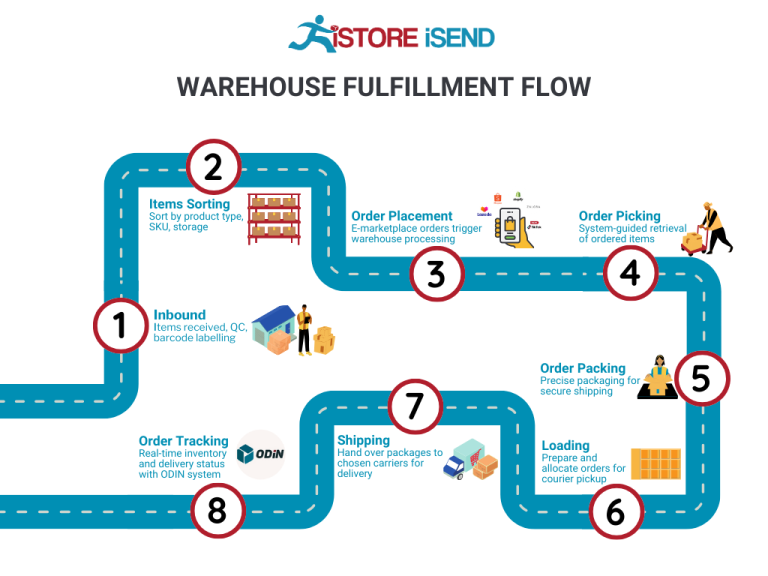
Key Term: ABC Analysis – This inventory categorization method prioritizes items based on their importance. “A” items are high-value or fast-moving products, while “C” items are lower in value and slower moving. This helps in optimizing storage space and improving pick efficiency.
3. Order Picking
Order picking is the process of retrieving items from storage to fulfill a customer’s order. Warehouse staff use various methods to pick items, such as single order picking (retrieving items for one order at a time) or batch picking (retrieving items for multiple orders simultaneously).
Importance: The accuracy and speed of order picking directly affect customer satisfaction. Mistakes in this step can lead to incorrect orders, which not only frustrate customers but also increase return rates and operational costs.
Key Term: Pick Lists – These are documents or digital tools that outline the items and quantities needed for each order. A well-organized pick list helps pickers work efficiently and minimizes errors.
4. Order Packing
After items are picked, they move to the packing stage. This involves carefully packaging products to prevent damage during transit. Packaging also includes labeling shipments with relevant information such as the shipping address, tracking numbers, and any special handling instructions.
Importance: Effective packing ensures that products arrive in good condition, which is crucial for maintaining customer trust and satisfaction. Additionally, well-packed items can reduce shipping costs by optimizing box sizes and weight.
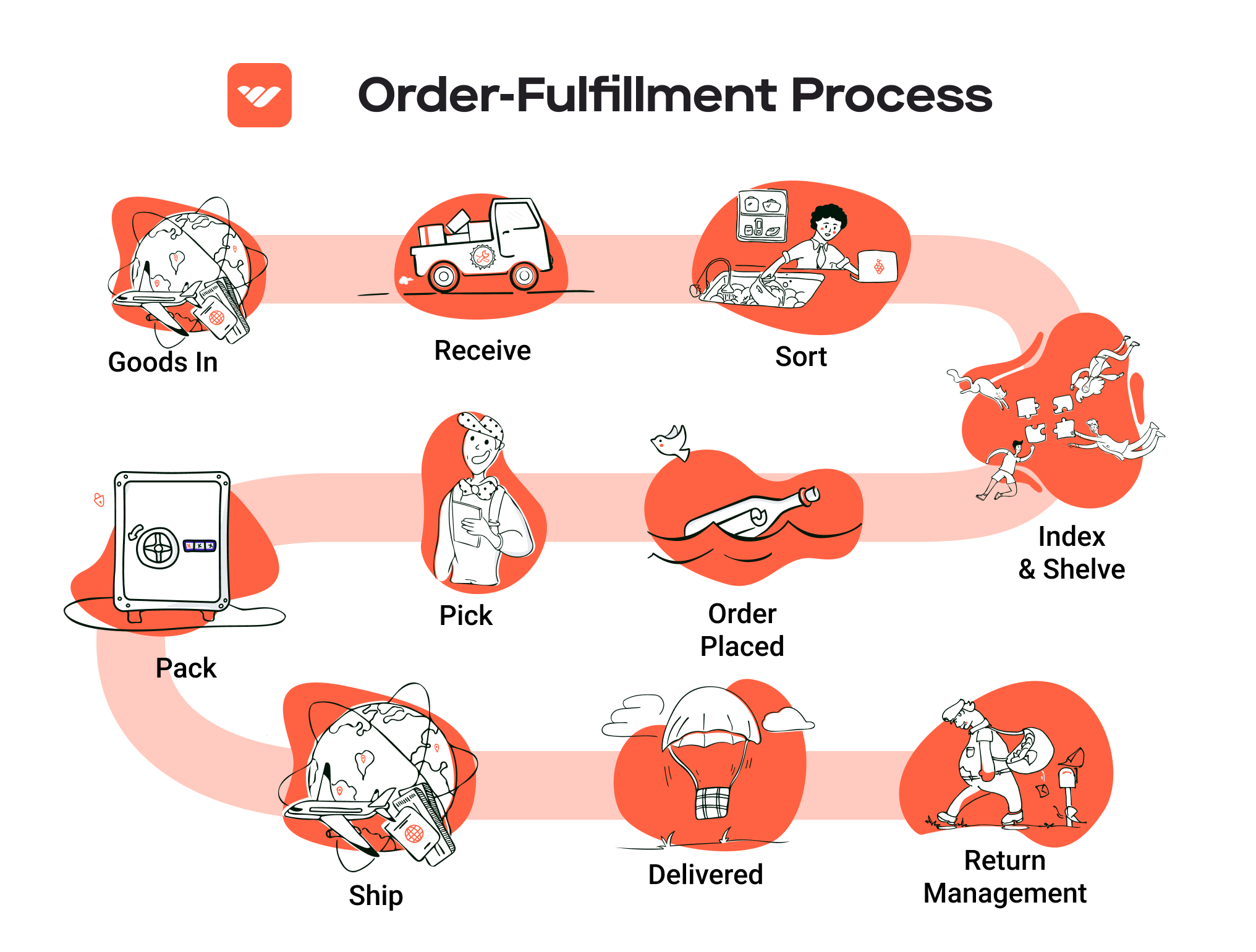
Key Term: Packing Slip – This document accompanies the order and lists the items included in the shipment. It serves as a confirmation for both the warehouse staff and the customer, ensuring that the correct items are sent.
5. Shipping & Delivery
The final step is shipping and delivery, where packed orders are handed off to carriers for transportation to the customer’s address. This step involves selecting the appropriate shipping method based on factors like cost, speed, and destination.
Importance: Timely delivery is a critical factor in customer satisfaction. The shipping process must be managed efficiently to ensure that orders reach customers within the promised time frames.
Key Term: Last Mile Delivery – This term refers to the final leg of the delivery process, where the package is transported from a distribution center to the end customer. Optimizing this stage can significantly enhance the overall customer experience.
By understanding and optimizing each step of the order fulfillment process, e-commerce businesses can improve operational efficiency, reduce costs, and enhance customer satisfaction. This structured approach not only helps in scaling operations but also positions businesses for long-term success in a competitive marketplace.
Comparing Fulfillment Models: In-House vs. 3PL vs. Dropshipping
Overview of Fulfillment Models
When scaling an e-commerce business, selecting the right fulfillment model is pivotal. Each model—In-House Fulfillment, Third-Party Logistics (3PL), and Dropshipping—has its unique characteristics, benefits, and drawbacks. Understanding these differences can help business owners make informed decisions that align with their growth strategies.
| Model | Who Handles Inventory | Best For (Business Stage) | Key Advantage | Key Disadvantage |
|---|---|---|---|---|
| In-House Fulfillment | Business itself | Established businesses | Full control over inventory and operations | High overhead costs and complexity |
| Third-Party Logistics (3PL) | 3PL provider | Growing and mid-sized businesses | Scalability and reduced operational burden | Less control over inventory and processes |
| Dropshipping | Supplier | Startups and small businesses | Low startup costs and no inventory risk | Lower profit margins and potential quality issues |
In-House Fulfillment
In-house fulfillment involves managing all aspects of storage, inventory management, and shipping within the business. This model is ideal for established businesses that have the resources and infrastructure to handle logistics internally.
Advantages: One of the primary benefits of in-house fulfillment is the level of control it offers. Businesses can oversee every aspect of the process, ensuring quality control and the ability to respond quickly to customer needs. This model allows for customization in packaging and shipping, which can enhance brand identity and customer satisfaction. Additionally, in-house fulfillment can lead to lower shipping costs per unit when scaled effectively.
Disadvantages: However, in-house fulfillment also comes with significant challenges. The overhead costs associated with maintaining warehouse space, managing staff, and investing in technology can be substantial. As order volumes increase, the complexity of operations can grow, requiring additional investment in systems and processes. For businesses lacking experience in logistics, this can lead to inefficiencies and increased operational risks.
Third-Party Logistics (3PL)
Third-party logistics (3PL) providers offer outsourced logistics services, managing inventory storage, order fulfillment, and shipping on behalf of the business. This model is particularly beneficial for growing and mid-sized businesses looking to scale without the burden of logistics management.
Advantages: The key advantage of using a 3PL provider is the scalability it offers. Businesses can quickly adapt to changing order volumes without needing to invest heavily in warehousing or logistics infrastructure. 3PL providers often have established networks that can optimize shipping processes and reduce costs. This model also allows businesses to focus on core competencies such as marketing and product development while leaving logistics to experts.
Disadvantages: On the flip side, utilizing a 3PL can lead to a loss of control over inventory and fulfillment processes. Businesses may face challenges in ensuring that their brand standards are met, as they rely on an external provider. Communication issues can also arise, potentially leading to delays or mistakes in order fulfillment. Additionally, as 3PL services are typically priced based on volume, costs can escalate with increased order quantities.
Dropshipping
Dropshipping is a fulfillment model where the retailer does not hold inventory but instead relies on suppliers to ship products directly to customers. This model is especially popular among startups and small businesses due to its low barrier to entry.
Advantages: The most significant advantage of dropshipping is the minimal upfront investment required. Retailers do not need to purchase inventory until they receive orders, which reduces financial risk. This model also allows for a broad product selection without the need for physical storage space, making it easier for new businesses to test markets and adapt to trends quickly.
Disadvantages: Despite its advantages, dropshipping can lead to lower profit margins since retailers often pay a premium for the convenience of not holding inventory. Furthermore, reliance on suppliers can introduce quality control issues, as businesses have little oversight over the fulfillment process. Shipping times may also be longer, which can negatively impact customer satisfaction. Additionally, managing returns can be more complicated in a dropshipping model, potentially leading to customer service challenges.
Conclusion
Choosing the right fulfillment model is essential for the success of an e-commerce business. In-house fulfillment offers control but at a higher cost, while 3PL provides scalability and expertise but may sacrifice some control. Dropshipping allows for low-risk entry into the market but can lead to lower margins and quality issues. Business owners should carefully evaluate their current stage, resources, and long-term goals to select the model that best aligns with their operational strategy and customer expectations.
A Deep Dive into Amazon FBA: Pros, Cons, and Who It’s For
Understanding Fulfillment by Amazon (FBA)
Fulfillment by Amazon (FBA) is a service offered by Amazon that allows sellers to store their products in Amazon’s fulfillment centers. Amazon takes care of storage, packaging, shipping, and customer service for these products. This model enables sellers to leverage Amazon’s extensive logistics network and customer base to scale their businesses effectively.
When a customer orders a product listed with FBA, Amazon handles the entire fulfillment process. This includes picking the product from the warehouse, packing it, and shipping it to the customer. Furthermore, Amazon manages returns and customer inquiries related to these orders. This service provides a level of convenience and efficiency that many small to medium-sized businesses find invaluable.
How FBA Works
-
Setup: Sellers create an Amazon seller account and enroll in the FBA program. They then prepare their products according to Amazon’s guidelines and ship them to Amazon’s fulfillment centers.
-
Storage: Once received, Amazon stores the products in their warehouses. Sellers can view their inventory levels through the seller dashboard.
-
Order Fulfillment: When a customer places an order, Amazon takes care of the picking, packing, and shipping. Products fulfilled through FBA are eligible for Amazon Prime, which can increase sales significantly.
-
Customer Service: Amazon provides customer service for FBA orders, handling inquiries, refunds, and returns on behalf of the seller.
-
Reporting: Sellers have access to detailed reporting tools that help them track sales, inventory levels, and customer feedback.
Pros of FBA
-
Prime Eligibility: Products fulfilled by Amazon are automatically eligible for Amazon Prime. This can significantly enhance visibility and increase sales, as Prime members often prefer to purchase items that offer fast, free shipping.
-
Customer Trust: By utilizing FBA, sellers benefit from Amazon’s trusted reputation. Customers are more likely to purchase products backed by Amazon’s customer service and return policies, leading to increased conversion rates.
-
Multi-Channel Fulfillment: FBA allows sellers to fulfill orders not just from Amazon but also from other sales channels, such as their own websites or other e-commerce platforms. This flexibility can streamline operations and reduce shipping costs.
-
Scalability: FBA enables sellers to scale their business without the need for extensive infrastructure. Amazon’s logistics capabilities can handle fluctuations in order volume, allowing sellers to focus on marketing and product development.
-
Inventory Management: Amazon provides tools and services to help sellers manage their inventory effectively. This includes alerts for low stock and suggestions for restocking based on sales trends.
Cons of FBA
-
High Fees: While FBA can save time and effort, it comes with various fees that can impact profitability. These include storage fees, fulfillment fees, and additional charges for long-term storage. Sellers must carefully analyze their pricing strategy to ensure they remain profitable.
-
Strict Inventory Rules: Amazon has stringent policies regarding inventory management. Sellers must adhere to specific packaging and labeling requirements, and failure to comply can lead to penalties or even account suspension.
-
Commingling Risks: FBA may involve commingling inventory, meaning that products from different sellers are stored together. This can lead to concerns about product integrity, especially if counterfeit or damaged items are mixed in with legitimate stock. Sellers may face challenges in tracking their specific inventory.
-
Loss of Control: When using FBA, sellers relinquish some control over the fulfillment process. They must rely on Amazon’s systems and procedures, which may not always align with their business practices or customer service expectations.
-
Complex Returns Process: While Amazon handles returns, the process can be complex for sellers, especially if they sell a variety of products. Understanding how returns are processed and managing customer expectations can be a challenge.
Who is FBA Best For?
Fulfillment by Amazon is particularly advantageous for:
-
Small to Medium-Sized Sellers: Businesses that lack the infrastructure or resources to manage their own warehousing and fulfillment can benefit greatly from FBA’s logistics capabilities.
-
Brands Looking to Scale: Companies aiming to grow their sales quickly and reach a wider audience can leverage FBA to streamline their operations while focusing on marketing and product development.
-
E-commerce Entrepreneurs: New entrants in the e-commerce space who want to minimize upfront costs and risks can start with FBA to test their products in the market without the burden of managing logistics.
-
Sellers with Seasonal Products: Businesses that experience fluctuations in demand, such as seasonal products, can benefit from the scalability of FBA without the need to invest heavily in warehousing.
-
Multi-Channel Sellers: Brands that sell across various platforms can use FBA to simplify their fulfillment process, allowing them to focus on their core business strategies.
In conclusion, while FBA presents numerous advantages for scaling e-commerce businesses, it is essential for sellers to weigh these against the potential drawbacks. Understanding the operational intricacies and financial implications of FBA will enable businesses to make informed decisions and leverage Amazon’s powerful platform effectively.
Core Services Offered by Fulfillment Centers
Inventory Management & Warehousing
Inventory management and warehousing are foundational services provided by fulfillment centers, designed to streamline the storage and organization of products. This service entails the systematic tracking of inventory levels, orders, sales, and deliveries, ensuring that e-commerce businesses maintain optimal stock levels to meet customer demand without overstocking.
Benefits:
-
Real-Time Inventory Tracking: Fulfillment centers utilize advanced software solutions that provide real-time visibility into inventory levels. This allows e-commerce businesses to monitor stock availability and make informed purchasing decisions, reducing the risk of stockouts or excess inventory.
-
Efficient Space Utilization: By leveraging the expertise of fulfillment centers, businesses can optimize their warehouse space. Fulfillment centers are designed to maximize storage efficiency, allowing for better organization and quicker access to products, which enhances overall operational efficiency.
-
Cost Savings: Outsourcing inventory management to fulfillment centers can significantly reduce overhead costs associated with maintaining a warehouse. Businesses can avoid expenses related to leasing warehouse space, utilities, and staffing, thereby improving profit margins.
-
Scalability: As e-commerce businesses grow, their inventory needs may fluctuate. Fulfillment centers offer scalable solutions that can easily adapt to changing demand, allowing businesses to expand without the complexities of managing additional warehousing.
Pick and Pack Services
Pick and pack services are crucial for the fulfillment process, involving the selection (or “picking”) of ordered items from the warehouse and packaging them for shipment. This service is essential for ensuring that customers receive the correct products in a timely manner.
Benefits:
-
Accuracy in Order Fulfillment: Fulfillment centers employ sophisticated picking technologies and processes that minimize human error. This ensures that the right products are picked and packed, enhancing customer satisfaction and reducing return rates.
-
Speedy Processing: With dedicated staff and optimized workflows, fulfillment centers can significantly speed up the order processing time. Quick turnaround on orders helps businesses meet customer expectations for fast delivery, a critical factor in e-commerce success.
-
Custom Packaging Options: Many fulfillment centers offer customizable packaging solutions, which allow e-commerce businesses to enhance their brand presence through unique packaging. This can also include the option for gift wrapping or including promotional materials, adding value to the customer experience.
-
Integration with E-commerce Platforms: Fulfillment centers often integrate seamlessly with e-commerce platforms, enabling automatic order processing. This integration reduces manual work and ensures that orders are fulfilled as soon as they are placed, further enhancing operational efficiency.
Kitting and Assembly
Kitting and assembly services involve the grouping of various products together into a single package or assembling products before shipping. This service is particularly beneficial for businesses that offer bundled products or complex items that require pre-assembly.
Benefits:
-
Enhanced Product Offering: Kitting allows e-commerce businesses to create unique product bundles that can attract more customers. By offering complementary products together, businesses can increase average order value and improve customer satisfaction.
-
Streamlined Assembly Process: For products that require assembly, fulfillment centers can handle this process efficiently. This saves businesses time and resources, allowing them to focus on core operations while ensuring that products are ready for immediate sale.
-
Inventory Management Efficiency: Kitting can improve inventory management by consolidating multiple SKUs into a single kit. This reduces the complexity of managing numerous individual items, simplifying stock tracking and replenishment processes.
-
Cost Efficiency: Outsourcing kitting and assembly to fulfillment centers can lead to cost savings in labor and equipment. Businesses can avoid the need for specialized staff or equipment for assembly, allowing them to allocate resources more effectively.
Returns Management (Reverse Logistics)
Returns management, or reverse logistics, is an essential service provided by fulfillment centers to handle product returns efficiently. This service encompasses the processes involved in receiving returned products, inspecting them, and restocking or disposing of them appropriately.
Benefits:
-
Streamlined Return Processes: Fulfillment centers implement streamlined processes for managing returns, making it easier for customers to return items. This can enhance customer satisfaction and loyalty, as a hassle-free return process is often a significant factor in e-commerce purchasing decisions.
-
Inventory Replenishment: Efficient returns management ensures that returned items are quickly assessed and restocked if they are in sellable condition. This helps maintain accurate inventory levels and reduces losses due to unsold returned products.
-
Data Insights: Fulfillment centers can provide valuable insights into return trends, helping businesses understand why products are being returned. This information can guide product development, marketing strategies, and inventory management decisions to reduce future returns.
-
Cost Reduction: By outsourcing returns management, e-commerce businesses can reduce the overhead costs associated with processing returns in-house. Fulfillment centers have established systems and expertise that can handle returns more efficiently, translating to lower operational costs.
In summary, the core services offered by fulfillment centers—inventory management and warehousing, pick and pack services, kitting and assembly, and returns management—are critical for e-commerce businesses looking to scale effectively. By leveraging these services, businesses can enhance operational efficiency, improve customer satisfaction, and ultimately drive growth in a competitive market.
How to Choose a Fulfillment Partner: A 6-Point Checklist
Location & Warehouse Network
Importance: The geographical location of your fulfillment partner’s warehouses is crucial for optimizing shipping times and costs. A partner with strategically located warehouses can help reduce delivery times to your customers, especially in a market where quick shipping is a competitive advantage.
Questions to Ask:
– Where are your warehouses located? How many do you operate?
– What is the average shipping time to major markets from your warehouses?
– Do you have a plan to expand your warehouse network in the future?
Technology & Integrations
Importance: An efficient and transparent fulfillment process relies heavily on technology. Your fulfillment partner should have a robust technology stack that integrates seamlessly with your e-commerce platform, inventory management systems, and other tools you use. This integration ensures real-time inventory tracking, order management, and streamlined operations.
Questions to Ask:
– What technology do you use for order management and inventory tracking?
– Can your system integrate with my existing e-commerce platform (e.g., Shopify, WooCommerce)?
– How do you handle data security and customer information?
Specializations (e.g., Cold Storage, Oversized Items)
Importance: Different products require different handling and storage conditions. If your business involves special items, such as perishable goods or oversized products, your fulfillment partner must have the necessary infrastructure and expertise to manage these effectively.
Questions to Ask:
– Do you offer specialized services like cold storage or handling of oversized items?
– What are your procedures for handling and storing such products?
– Can you provide case studies or references from clients with similar needs?
Scalability & Capacity
Importance: As your business grows, your fulfillment needs will likely change. It’s essential to choose a partner who can scale with your business, whether that means handling increased order volumes or expanding service offerings. A partner with sufficient capacity can help you avoid fulfillment bottlenecks during peak seasons.
Questions to Ask:
– What is your current capacity for order fulfillment, and how do you handle peak seasons?
– How quickly can you scale operations if my order volume increases?
– Do you have a plan in place for managing seasonal fluctuations in demand?
Pricing and Contracts
Importance: Understanding the pricing structure is vital to ensure that you’re not only getting a good deal but also that there are no hidden costs that could affect your bottom line. Transparent contracts can help you avoid misunderstandings and ensure a mutually beneficial partnership.
Questions to Ask:
– What is your pricing model? Are there additional fees for services like returns or storage?
– How do you handle pricing adjustments during contract renewals?
– Can you provide a detailed breakdown of all potential costs?
Customer Support & Reviews
Importance: Reliable customer support is critical for resolving issues quickly and maintaining smooth operations. Additionally, checking reviews and references can provide insights into the partner’s reliability and service quality.
Questions to Ask:
– What is your customer support structure? Is support available 24/7?
– How do you handle complaints or issues that arise?
– Can you provide references or testimonials from current or past clients?
Conclusion
Choosing the right fulfillment partner is a pivotal decision that can significantly impact your e-commerce operations and customer satisfaction. By carefully evaluating potential partners using this checklist, you can ensure that you select a provider that aligns with your business goals and growth trajectory. Remember, the right fulfillment partner not only supports your logistics needs but also contributes to your overall success in the competitive e-commerce landscape.
Understanding Fulfillment Pricing: A Breakdown of Common Fees
Initial Setup Fees
Initial setup fees are the costs associated with onboarding your business into a fulfillment center. These fees can vary significantly among providers but typically cover the integration of your e-commerce platform with the fulfillment system, setting up your inventory management, and configuring any necessary software.
The calculation of initial setup fees often includes:
– Software Integration: Costs associated with connecting your e-commerce platform (like Shopify, WooCommerce, etc.) to the fulfillment provider’s system.
– Inventory Setup: Fees for entering your products into the system, which may involve SKU creation and barcoding.
– Training and Support: Some providers charge for initial training sessions or ongoing support to help you navigate their systems.
To get a clear understanding of these costs, request detailed quotes from potential fulfillment partners, ensuring you know what is included in the setup package.
Receiving Fees
Receiving fees are charged when your inventory arrives at the fulfillment center. This fee covers the labor and resources needed to unload, inspect, and inventory your products.
The calculation of receiving fees typically considers:
– Volume of Goods: Fees may be charged per pallet or per unit, depending on the provider’s pricing structure.
– Inspection Requirements: If your goods require special handling or quality checks, additional fees may apply.
– Time Spent: Some providers may charge based on the time it takes to process your shipment.
To minimize receiving fees, ensure shipments are organized and correctly labeled, and communicate any special handling requirements in advance.
Storage Fees (per pallet/bin)
Storage fees are recurring costs associated with holding your inventory at the fulfillment center. These fees can be calculated on a per pallet or per bin basis, depending on how the provider organizes their warehouse.
Factors influencing storage fees include:
– Space Utilization: The more efficiently you utilize space (e.g., stacking items or using smaller bins), the lower your costs may be.
– Duration of Storage: Some providers charge a flat monthly fee, while others may have tiered pricing based on the length of time items are stored.
– Seasonal Variability: During peak seasons, storage fees may increase due to higher demand for warehouse space.
To keep storage costs manageable, regularly review your inventory levels and adjust your replenishment strategies to avoid overstocking.
Pick & Pack Fees (per item/order)
Pick and pack fees are charged for the process of selecting items from storage and preparing them for shipment. These fees are typically calculated per item or per order, and they encompass both the picking and packing processes.
Key components of pick and pack fee calculations include:
– Number of Items: Generally, the more items in an order, the higher the pick and pack fee.
– Complexity of Orders: If your orders require special packing materials or complex assembly, expect additional charges.
– Frequency of Orders: Some fulfillment centers offer discounts for businesses that maintain a high volume of orders.
To optimize pick and pack fees, streamline your product offerings and consider bulk orders to reduce the number of individual shipments.
Shipping Fees
Shipping fees are the costs incurred to deliver your products to customers. These fees can vary widely based on the shipping method selected, the carrier used, and the destination.
Shipping fee calculations typically involve:
– Weight and Dimensions: Carriers often charge based on the weight and size of the package, so accurate measurements are critical.
– Destination Zone: Shipping costs increase with distance, with different zones assigned varying rates.
– Service Level: Options like standard, expedited, or overnight shipping come with different price points.
To manage shipping costs effectively, negotiate rates with carriers, consider offering flat-rate shipping options, and explore using regional carriers for local deliveries.
Tips for Getting an Accurate Quote
-
Provide Detailed Information: When requesting quotes, be specific about your product types, volumes, and any special handling requirements to ensure accurate pricing.
-
Request Itemized Quotes: Ask for a breakdown of all potential fees, including initial setup, receiving, storage, pick and pack, and shipping, to avoid surprises later.
-
Compare Multiple Providers: Don’t settle for the first quote. Compare offerings from several fulfillment centers to find the best balance of services and pricing.
-
Inquire About Discounts: Many fulfillment centers offer discounts based on order volume or long-term contracts. Always ask about potential savings.
-
Understand Terms and Conditions: Be aware of any additional charges that may apply, such as for returns or changes in inventory levels, to ensure a comprehensive understanding of costs.
By understanding these common fulfillment pricing models and following the tips provided, e-commerce business owners can make informed decisions that align with their operational goals while optimizing costs.
Frequently Asked Questions (FAQs) about Fulfillment
1. What is fulfillment in e-commerce?
Fulfillment in e-commerce refers to the complete process of receiving, processing, and delivering orders to customers. This includes inventory management, order processing, packaging, shipping, and handling returns. A well-optimized fulfillment process is essential for customer satisfaction and operational efficiency.
2. What’s the difference between a warehouse and a fulfillment center?
A warehouse is primarily used for storage of goods and may not have the capabilities to process orders. In contrast, a fulfillment center is designed specifically for the entire order fulfillment process, including receiving inventory, picking and packing orders, and shipping them directly to customers. Fulfillment centers often utilize technology for inventory management and order tracking to enhance efficiency.
3. What is a 3PL (Third-Party Logistics)?
A 3PL is a service provider that manages logistics and fulfillment operations on behalf of e-commerce businesses. This includes warehousing, inventory management, order processing, and shipping. Using a 3PL allows businesses to focus on their core operations while leveraging the expertise and infrastructure of logistics specialists.
4. How much do fulfillment services cost?
Fulfillment service costs can vary widely based on factors such as order volume, storage space, shipping methods, and additional services like packaging or returns processing. On average, businesses can expect to pay between $2 to $5 per order for fulfillment services, plus storage fees that can range from $10 to $50 per pallet per month. It’s essential to obtain quotes from multiple providers to find a service that meets your budget and needs.
5. How can I improve my fulfillment process?
To enhance your fulfillment process, consider the following strategies: streamline inventory management to reduce stockouts and overstock situations, automate order processing with software solutions, optimize shipping methods for cost and speed, and regularly review your logistics partners for performance and reliability. Continuous improvement and feedback loops will help maintain efficiency.
6. What role does technology play in fulfillment?
Technology plays a crucial role in modern fulfillment operations. It enables real-time inventory tracking, automated order processing, data analytics for performance monitoring, and integration with e-commerce platforms. Utilizing fulfillment software can enhance accuracy, speed up processing times, and improve customer service by providing tracking information.
7. What are the benefits of using a fulfillment service?
Utilizing a fulfillment service can lead to several benefits, including reduced operational costs, improved shipping times, scalability as your business grows, and the ability to focus on marketing and sales rather than logistics. Additionally, many fulfillment services offer expertise in handling complex logistics challenges, which can enhance customer satisfaction.
8. How do I choose the right fulfillment partner?
When selecting a fulfillment partner, consider factors such as their experience in your industry, technology capabilities, geographic location, pricing structure, and customer service reputation. It’s also beneficial to request case studies or references to understand their performance and reliability.
9. What is the importance of inventory management in fulfillment?
Effective inventory management is critical in fulfillment as it ensures that products are in stock and ready to ship when orders are placed. Poor inventory management can lead to stockouts, overstocks, and increased operational costs. Implementing inventory management systems helps in tracking stock levels, forecasting demand, and automating reordering processes.
10. How can I handle returns efficiently?
Efficient return handling can significantly impact customer satisfaction and retention. To manage returns effectively, establish a clear return policy, automate the return process with easy-to-use software, and provide customers with return shipping labels. Analyzing return data can also provide insights into product performance and areas for improvement in your fulfillment strategy.
Conclusion: Is Outsourcing Fulfillment the Right Move for Your Business?
Evaluating the Benefits of Outsourcing Fulfillment
As you contemplate the journey of scaling your e-commerce business, outsourcing your fulfillment can serve as a strategic catalyst for growth. The key benefits of utilizing a fulfillment service are manifold, primarily centering on time savings, scalability, and access to specialized expertise.
Firstly, by delegating fulfillment responsibilities, you free up precious time that can be redirected toward core business activities, such as marketing and product development. Instead of managing inventory, packing orders, and handling shipping logistics, you can focus on strategic initiatives that drive revenue and improve customer engagement.
Secondly, a fulfillment partner provides scalability that is essential for growing businesses. As your sales volume fluctuates, especially during peak seasons, a third-party fulfillment service can seamlessly adjust to your needs. This flexibility allows you to manage increased order volumes without the headaches of hiring additional staff or expanding warehouse space.
Finally, partnering with a fulfillment service grants you access to a wealth of industry expertise. These professionals are adept at optimizing shipping processes, reducing costs, and ensuring that your products reach customers promptly. Their experience can significantly enhance customer satisfaction, a critical factor in today’s competitive e-commerce landscape.
However, choosing the right fulfillment partner is crucial for your growth trajectory. Not all services are created equal; it’s vital to assess their capabilities, technology, and reliability to ensure they align with your business goals.
Take Action
To determine if outsourcing fulfillment is the right move for your business, conduct a thorough audit of your current shipping processes. Assess your fulfillment costs, delivery times, and customer feedback. This evaluation will provide clarity on whether a fulfillment partner can enhance your operational efficiency and support your growth ambitions. Don’t hesitate to explore this potential next step in your e-commerce journey!
Important Disclaimer
⚠️ Important Disclaimer
The information in this guide is for educational purposes. Fulfillment services, pricing, and platform features change frequently. Always conduct your own due diligence and consult with providers directly before making business decisions.
